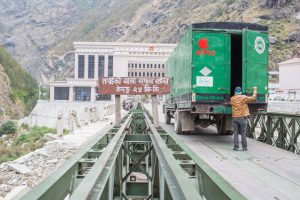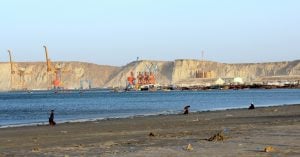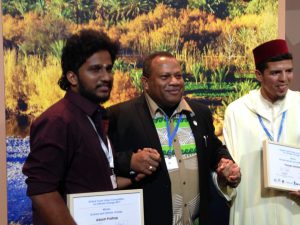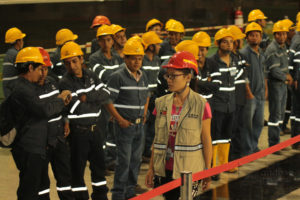The use of rivers for trade and transit in South Asia has been a traditional means of connectivity for ages. The rivers Ganga and Brahmaputra in India have also supported multi-modal connectivity for Nepal and Bangladesh even before colonial era. As roadways choke with congestion and fuel prices increase, waterways are being rejuvenated as an alternate and environmental friendly mode of transport among Bangladesh, India and Nepal.
The Indo-Nepal connectivity agenda has historically been dogged by negotiations of nitty-gritties about who gives what and who gets what. Hence, river connectivity could possibly give Nepal an upper hand given that navigation is a non-consumptive freshwater ecosystem service. Nepal being the upper riparian country also has a substantial bargain to make with India and Bangladesh as the lower riparian countries on the Ganga.
To make this possible, though, infrastructural development has to be coupled with governance reforms.
Navigation in Nepal
In Nepal, the development of rivers as waterways has been inhibited due to the lack of multiple infrastructural and governance reforms. While the Ministry of Transport in Nepal deliberates on these emerging areas of governance, it is imperative to note that the Himalayan rivers of Nepal follow a different geography as compared to the rivers in the plains of the Indian subcontinent. Hence the navigational usage of rivers in Nepal has to be taken with a pinch of salt.

Physically, rivers like Saptakoshi, Kali Gandaki, Trishuli, Bheri, and Karnali have been found to be feasible for non-mechanised navigation. Among these rivers, scoping studies show that some stretches on Gandak/Narayani (Devghat-Ramdi, Mugling-Fisling, Mirme-Setibeni) and Koshi (Chatara-Simile, Dolalghat-Chatara) are currently being utilised for non-mechanised navigation (like river tourism and local transportation). In addition to this, the Ministry of Physical Infrastructure and Transport in Nepal has also established through a scoping study that the river geography is unsuitable for motorised navigation and the training of rivers is also an investment-intensive initiative.
This brings policymakers to the question on how can Nepal access the large-scale markets in the Bay of Bengal (BoB) region through waterways in India.
Navigation through India
Currently Nepal has access to the sea through the Vishakhapatnam port in India with a caveat of high logistical costs for cargo through the roadways. However, reduced costs through waterways and by extension access to the markets of BoB region can be availed only through the Kolkata port in India.
For Nepal to access the national waterways (NW) of India, two rivers in India can be utilised: the Gandak and the Kosi. On the Gandak, NW-37 (Bhaisaslotlal barrage-Hajipur) and on Kosi NW-58 (Kosi barrage-Kursela), seem to be the answer for Nepal’s river entry points.
Field studies at Triveni dham, Nawalparasi, in Nepal indicate that the navigation prospects are limited to religious tourism and fishing purposes currently on the Nepal side. Stakeholders also shared that around 50 years ago, Tribeni used to be a thriving local trade centre for roadways and waterways. Tribeni was also the first river port for bartering of goods coming from India and the hilly terrain of Nepal. However, construction of the barrage and the East-West Highway has diverted the cargo traffic to the roadways now.
On the Indian side, navigation along the Gandak from Bhaisaslotlal barrage at Triveni dham to Hajipur at Patna is yet to be explored for transboundary navigation. In the case of the Kosi, expanding river tourism from Koshi Tappu Wildlife Reserve to Barahkshetra, Saptakoshi and all the way up to Arun river have been pointed out as sole navigational purposes. Physically, the Kosi will require immense infrastructural investments for river training and industry development due to its flood-prone and sediment carrying nature.
With an estimated cargo potential of 11.76 million tonnes per annum, NW-37 is likely to be operationalized by January 2019 and seems to exhibit higher potential than NW-58 for Indo-Nepal river connectivity. Absence of sizable domestic industries along the Kosi in India also adds to the conundrum of economic feasibility of NW-58. The transportation of goods across the Bhaisaslotlal barrage and the Kosi barrage would require not only technical feasibility (depth, and clear channels) in the river but also other regulatory and infrastructural developments such as river customs stations, immigration office and quarantine facilities.
Navigating waterway governance
NW-37 and NW-58 end up merging with NW-1 (Allahabad-Haldia) in Bihar. While the Gaighat terminal at Patna will direct traffic as usual, India is also building an intermodal terminal at Kalughat near Patna specifically to cater to Nepal-bound cargo traffic demands from Kolkata. Other terminals like Gazipur and Sahebgunj on NW-1 can also handle the distribution of such cargo traffic. Irrespective of the waterway that will be used for Indo-Nepal connectivity, the kind of products and cargo to be transported and economies of scale would take precedence over all such geo-political considerations.
A hopeful private sector in Nepal suggests that non-timber forest products like ginger, cardamom, and turmeric #from the hilly terrains of Nepal can be the cargo categories to be transported from Nepal to the markets of the BoB region. However, whether these perishable horticultural products can survive the long transit period across Gandak and Kosi is yet to be determined by concerned governance bodies.
Meanwhile the establishment of clear polices by concerned governance bodies in Nepal and India is another grey area. In India, at the state-level, inland water transport departments and at the union-level, the Inland Waterways Authority of India (under the aegis of Ministry of Shipping) are coordinating the maintenance and governance of the waterways. In Nepal, a desk does exist for the governance of waterways and cableways (under the aegis of Ministry of Physical Planning and Transport), but its functions are yet to be streamlined with that of the national transport and connectivity guidelines. The governance structures exist as an area of concern primarily due to the nascent stages of development and trans-boundary nature of river connectivity.
As Nepal and India look forward to exchanging future trans-boundary negotiations, the thumb rule for navigational usage remains that Nepal will have to adopt a multi-modal connectivity approach to utilise India’s waterways. India and Nepal can also adopt a strategy similar to that of Bhutan’s memorandum of understanding with Bangladesh to use Narayanganj port for access to sea. Overall, India needs to shift its stance from the talking to focussing on regulations when it comes to steering navigation priorities in the Indo-Nepal connectivity agenda for trade and transit.
![<p>The rafters of Nepal transporting bamboo down the Kosi into India [image by: Nabin Baral]</p>](https://dialogue.earth/content/uploads/2017/12/Bamboo-rafters.jpg)






